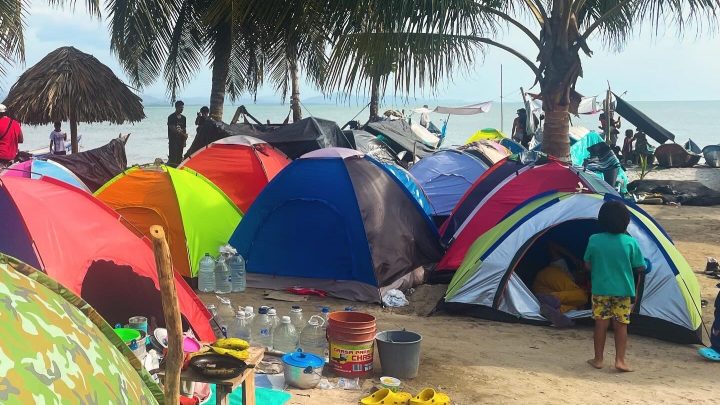
How migration altered the economy of this Colombian town

This story was produced by our colleagues at the BBC.
Migrants traveling through South America to reach the southern U.S. border by land must cross the Darién Gap, a dangerous, dense stretch of jungle on the border of Colombia and Panama.
Last year, half a million people made this journey, according to the United Nations refugee agency. The small Colombian seaside town of Necoclí is a key staging post — a place where migrants stock up on supplies before starting the arduous trek. And this migration boom has changed the town’s economy.
Hotel owner Heroldo Vergaro now knows some Mandarin because many of his guests are Chinese — not tourists, but migrants hoping to get to the U.S.
“The tourists are sporadic and what’s happening now is permanent,” said Vergaro. “Before, I would get 20 people a month — now I can get 20 people a week.”

Since the acute phase of the COVID-19 pandemic ended, people from around the world have traveled through Necoclí because of its proximity to new migration routes across the Darién Gap, which takes days to trek through.
Traditionally dependent on domestic tourism, Necoclí’s economy has undergone a rapid transformation. “It’s changed. It’s better. Right now, Necoclí is living off migration,” said Vergaro.
Not far from the hotel, hundreds of people camp in clusters of colorful tents along the palm-fringed beach, unable to afford better accommodation.
They buy their tents from shops like Joaquín Vélez’s, whose profits have shot up since he switched from groceries to selling items migrants might need on their journeys. But Vélez feels conflicted.
“I find myself in a dilemma,” he said. “I don’t want this to end because we’re financially buoyant. But at the same time you feel people are suffering a lot.”

Many locals have pivoted their businesses in this way; others rent out rooms in their homes and some have become guides, taking migrants to Panama through the Darién Gap.
Prices for the crossing start at $350 per person, but the journey can be five times as much. A hefty part of this fee goes to the Gulf Clan, a powerful criminal group in Colombia which has made around $60 million from migration through the Darién Gap, according to Human Rights Watch.
The majority of migrants arriving in Necoclí are Venezuelan, but others come from places like Haiti and Afghanistan. Carlos Rojas, the town’s secretary for tourism, productivity and economic development, still considers Necoclí a tourist town but said migration is helping it to flourish.
“Some migrants came with purchasing power, what we call ‘dollarized migration.’ We saw that as an opportunity and we started to improve a lot of infrastructure. Right now, it’s benefiting us and we see this migration as an opportunity for economic development.”
But not all businesses are benefiting from the migration boom. Shop owner Rosa, who didn’t want to give her full name, said she struggles to sell beach balls and swimsuits. The increase in migration has had a negative impact on tourism — and therefore sales from tourists, she said.
“We lived well off tourism,” she said. “But an immigrant doesn’t come to buy a swimsuit; they don’t come to buy something that leaves you with any profit.”
Back at Heroldo Vergaro’s hotel, he remembers his guests fondly. “Sometimes, when they are in the U.S. they call me: ‘We’ve arrived! We’re in this part.’”
For him, the arrival of people from around the world has meant more customers — and new friends — but for others, like Rosa, it’s made it harder to survive.
There’s a lot happening in the world. Through it all, Marketplace is here for you.
You rely on Marketplace to break down the world’s events and tell you how it affects you in a fact-based, approachable way. We rely on your financial support to keep making that possible.
Your donation today powers the independent journalism that you rely on. For just $5/month, you can help sustain Marketplace so we can keep reporting on the things that matter to you.











